When Japan comes to mind, Mount Fuji is undoubtedly one of the first images that springs to memory. But how much do you really know about this iconic landmark? You might already be aware that Mount Fuji is an active volcano, boasting the title of Japan’s highest peak, and nestled near the Fuji Five Lakes. However, there’s a wealth of lesser-known facts about Mount Fuji waiting to be uncovered.
Have you ever pondered which side of the Shinkansen (bullet train) offers the most breathtaking view of Mount Fuji? Or questioned why this majestic mountain appears snow-capped? And is Mount Fuji privately owned, or does it belong to the Japanese government? Before embarking on your journey to Japan, let’s delve into some intriguing trivia about Mount Fuji to infuse your adventure with a dash of ‘Fuji flavor’.
What’s more: A Must-Buy Souvenir: Mt. Fuji-shaped Bread at Mt. Fuji and Lake Kawaguchi
Which Side of the Transportation Should You Sit on to See Mount Fuji?
Best Side to See Mount Fuji on the Shinkansen
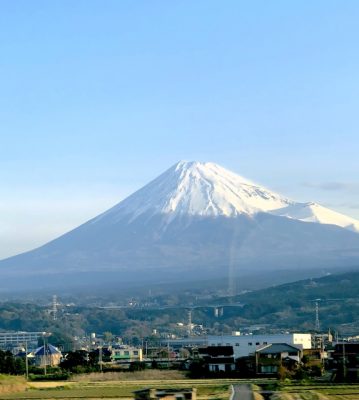
Japan Pocket Wifi Rental
UNLIMTED DATA SIM CARD
Japan Travel Prepaid SIM card
View of Mount Fuji from the Shinkansen
If you’re traveling on the Shinkansen from Tokyo to central areas such as Nagoya, Kansai areas like Osaka and Kyoto, or Kyushu areas like Fukuoka, opt for seats on the right side facing the direction of travel to catch a glimpse of Mount Fuji. Conversely, if your journey takes you from Kansai to Tokyo, make sure to secure seats on the left side facing the direction of travel to enjoy the scenic view of Mount Fuji from your window!
For airplanes, the optimal seating for Mount Fuji views varies depending on the destination and airline.
Viewing Mount Fuji from Domestic Flights in Japan
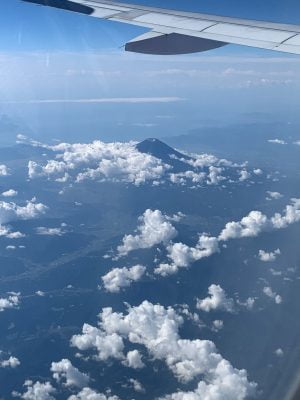
View of Mount Fuji from the left side when flying from Tokyo to Fukuoka
If you’re departing from Tokyo, particularly from Haneda Airport, and flying to destinations such as Fukuoka, Kanazawa, Okayama, Kobe, including northern regions like Nagoya, you’ll want to choose a seat on the left side of the plane for a view of Mount Fuji. Conversely, if your destination includes Osaka, Tokushima, Kochi, Kagoshima, Miyazaki, and southern regions, opt for a seat on the right side.
Returning to Tokyo from central, Kansai, Kyushu, Hokuriku, and other regions, routes from Nagoya, Kanazawa, Toyama, Okinawa, and other islands may not provide a view of Mount Fuji. However, for most other airports, Mount Fuji is typically visible from the left side of the plane.
Reference: ANA – Which Side Can You See Mount Fuji?
Furthermore, if your flight route permits views of Mount Fuji, the in-flight announcement will notify passengers as the aircraft approaches the area where Mount Fuji is visible, specifying which side of the plane offers the best view. Generally, for flights departing from Haneda Airport, Mount Fuji becomes visible approximately half an hour after takeoff, so it’s advisable not to sleep through it!
Why is Mount Fuji white?
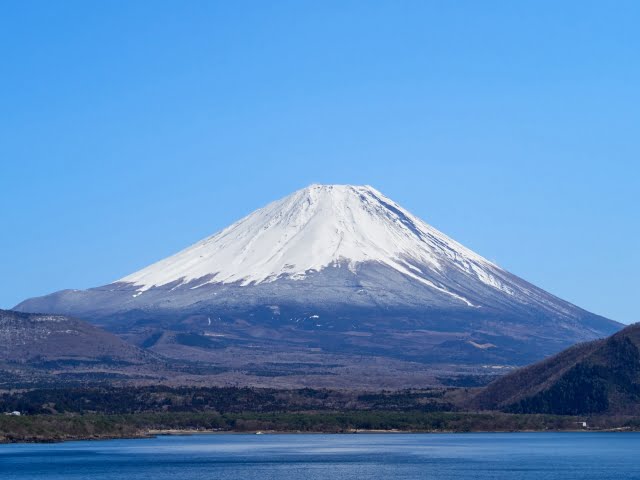
The white portion of Mount Fuji visible to the naked eye is where no trees grow. Without foliage to obstruct the view, the snow covering the mountain is clearly visible, presenting a white Mount Fuji.
Conversely, the green or dark-colored sections of Mt. Fuji you currently see are densely populated with trees, which shield the snow from view. Consequently, only the color of the leaves and trunks is visible.
Did you know that Mount Fuji is actually a piece of private land?
When asking Japanese individuals about the ownership of Mount Fuji, most would likely respond, ‘It belongs to everyone.’
However, not all of Mount Fuji is public property.
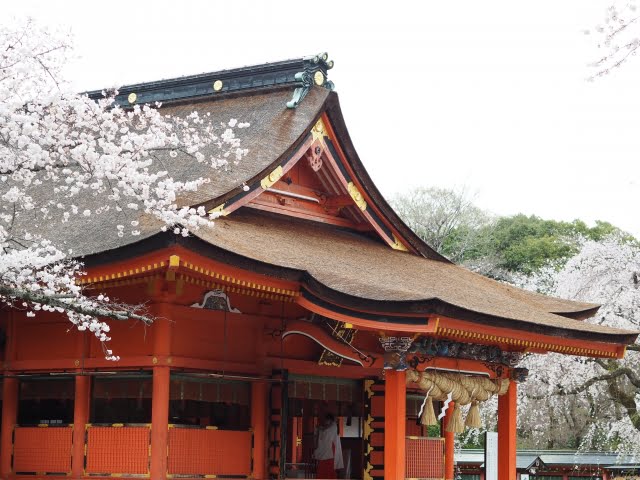
Fujisan Hongū Sengen Taisha (富士山本宮浅間大社)
In fact, from 3,360 meters to the summit, the land is privately owned, rather than national property. This territory is owned by Asama Shrine, with its main shrine situated in Fujinomiya City, Shizuoka Prefecture. The shrine holds ownership of all the land from Yagome to the summit of Mount Fuji.
Therefore, referring to the summit of Mount Fuji as the abode of the gods seems fitting, given its ownership.
Mt. Fuji’s Hasshinpo(eight-god peaks) has nine summits
At the summit of Mt. Fuji lies a vast volcanic crater known as Ouchiin (大内院), standing at 3,535 meters above sea level. Surrounding this crater are peaks collectively referred to as the ‘Hasshinpo’ or ‘eight-god peaks,’ formed through volcanic eruptions. The following is a list of these peaks according to a survey conducted by the Fuji Sand Defense Office of the Central Regional Development Bureau of the Ministry of Land, Infrastructure, Transport and Tourism of Japan, as compiled by the official Fuji Mountain Climbing website.
The summits of the Hasshinpo include:
- Kusushi-dake (久須志岳)
- Jouju-dake (成就岳)
- Izugatake (伊豆ヶ岳)
- Asahi-dake (朝日岳)
- Sengen-dake (浅間岳)
- Komagatake (駒ヶ岳)
- Mishima-dake (三島岳)
- Hakusan-dake (白山岳)
Additionally, Japan’s highest peak, Kengamine (剣ヶ峰), stands at an elevation of 3,776 meters above sea level.

So Mt. Fuji boasts nine summits!
But why are these nine summits referred to as the Hasshinpo, or ‘eight-god peaks’?
Interestingly, the term ‘eight’ is more of a symbolic rather than a literal number.
Centuries ago, the Japanese believed that eight Buddhas resided on Mount Fuji, with the remaining seven surrounding the central Vairocana (also known as Mahāvairocana). This depiction is found in many ancient Japanese artworks.
Later, in 1874, as a result of a distinction made between gods and Buddhas, the peaks atop Mount Fuji were dubbed the Hasshinpo, or ‘eight-god peaks,’ and each peak was given a new name.
However, in reality, the crater rim of Mount Fuji has formed numerous peaks, and depending on the counting method, there are anywhere from nine to thirteen prominent summits, with no strict rules or definitions. Therefore, the term Hasshinpo has persisted through the ages as a traditional name, with the number ‘eight’ serving merely as a general reference rather than an exact count of summits.
How was Mount Fuji formed?

Mount Fuji originated from a volcano known as the “Kofuji Volcano” or “Ancient Fuji Volcano”. The eruption of this ancient volcano expelled a significant amount of ash and volcanic rock, which combined with magma to give rise to the present-day Mt. Fuji. Approximately 10,000 years ago, the volcano erupted once more, ejecting magma and other materials that completely buried the ancient Fuji volcano, resulting in the mountain’s further elevation and the formation of the Mt. Fuji we recognize today.
What happens when you cook at the top of Mt.Fuji?

Indeed, cooking rice at the summit of Mount Fuji is impossible due to the atmospheric pressure.
At an altitude exceeding 3,700 meters, the air pressure atop Mt. Fuji is only around 63% of that at sea level, approximately 640 hPa. Consequently, the boiling point of water decreases accordingly, preventing it from reaching the standard 100°C even if it boils.
However, while rice cannot be cooked at the summit of Mt. Fuji, the boiled water at this altitude is actually ideal for brewing coffee. This is because the optimal extraction temperature for coffee is approximately 90°C, which aligns well with the temperature of water boiled at the peak of Mt. Fuji.
Mt. Fuji was once the largest saisen box in Japan
At the top of Mt. Fuji, which we mentioned above, there is a crater surrounded by Hasshinpo. This crater was once the largest saisen box.
Used to collect offerings, a saisen box is typically a wooden coin box, with a grate for the top cover. This design allows coins to be tossed in, while still preventing the money from being retrieved easily. Some have grates made of round bars, or have borders that slope downward, allowing the money to slide into the box easily.
From Wikipedia saisen
In the past, there was a time of “faith in climbing”, when people believed that the gods of heaven were based on Mount Fuji and climbed the mountain. At that time, people who made it to the top of Mt. Fuji safely would make a wish and put coins into the eruption crater at the top of Mt. Fuji, turning the crater at the top of Mt. Fuji into a saisen box with a diameter of 800m and a depth of 200m, which could fit 40 Tokyo Dome.
But now, for environmental reasons, it is no longer allowed to put anything into the crater. Everyone should be careful when climbing in the future.
The “rainfall” of Mt. Fuji is actually “rising rain” from the bottom to the top?
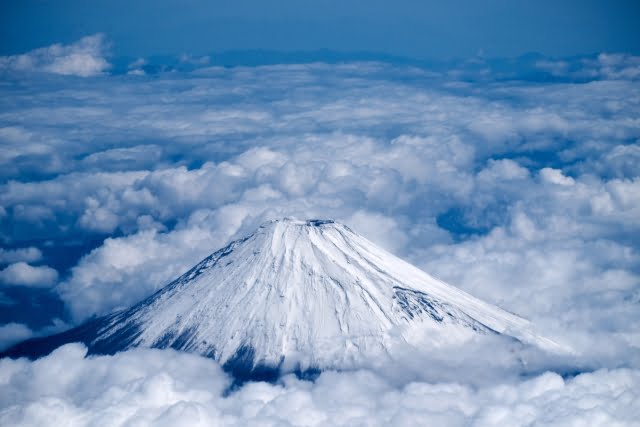
Typically, rain clouds form at altitudes ranging from 500m to 2000m. From the perspective of those on the ground, rain descends from above, hence the term ‘rainfall’. However, the highest peak of Mt. Fuji reaches 3776m, with more than one-third of the mountain towering above 2000m, surpassing the altitude at which rain clouds generate precipitation. Consequently, for these higher elevations exceeding 2000m, rain is actually generated below.
Under certain conditions, such as when strong winds blow upward during rainfall, a phenomenon known as rainwater floating upward from below may occur. If you’re hiking and encounter rain, it’s crucial to wear a waterproof raincoat. Traditional umbrellas won’t suffice on Mount Fuji’s higher slopes, as the rain originates from below. Getting wet in extremely low temperatures at high altitudes can lead to hypothermia, posing a serious risk to your safety.

GetAround Japan is your number one travel guide, providing the latest information on visiting and living in Japan, with tips on what to eat, things to do, and places to stay.
Whether you’re planning for a trip far in the future, or already in Japan in need of some fresh ideas, our archive of posts will help you find the best way to fill your time and get the most out of your travel experience.
We provide you updates on serious policies that affect visitors and foreign residents while also keeping things light and fun with articles on quirky trends and pop culture.
How do we know how to provide visitors the information they need? Our affiliate company CDJapan Rental provides WIFI and Sim Card rentals to thousands of visitors to Japan every year. In other words, we are constantly in touch with and listening to the voices of our customers, and infuse our blog with the information they ask us for.
For inquiries, contact us here
=Company Information=
CDJapan Rental (Neowing Corporation) 1-10-15-3F Nihonbashi Horidome Chuo, Tokyo 103-0012, Japan
Japan Pocket Wifi Rental
UNLIMTED DATA SIM CARD
Japan Travel Prepaid SIM card



